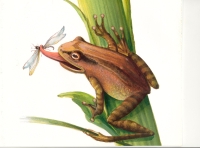| ________________
CM . . .
. Volume IX Number 19 . . . . May 23, 2003
excerpt:
A first book for both author and illustrator, Pacific Tree Frogs portrays the life cycle of the small amphibian that inhabits west coast wetlands. Beginning with the frogs' awakening from hibernation, the text describes the nocturnal call that begins the mating ritual, production of eggs and growth of tadpoles to froglets and finally mature tree frogs. Details on feeding habits, enemies and the return to hibernation are included. A final page discusses the drastic reduction in populations in recent decades due to habitat destruction. The book ends with a plea to save wetland and protect tree frogs.
Pacific Tree Frogs presents an interesting topic, and the general design is satisfying. Lack of attention to detail shows in some areas, however. Each double page spread is subtitled, but in such small print on the top left margin that the words were missed on first reading. The text is written in a simple, straightforward style with good sentence variety although the writing is uneven in spots: descriptions lack precise language (Songs are loud and beautiful) or the phrasing is awkward (Every time...habitat is destroyed, more tree frogs cannot breed). Illustrations range from sombre to brilliant, but the use of an unnatural looking green predominates in the pond scenes. The end papers are a murky green, with details difficult to decipher. Bird and mammal predators are simply shown against a plain white background, with no context clues and the less commonly seen spelling for 'racoon.' Overall, the illustrations lack a sense of harmony, and there is no buildup of dramatic interest. In many cases, the illustrations do not correspond well to the content. For example, "Hundreds of ...frogs call out..." but only three appear in the painting, and one of those is hard to find. One of the pages subtitled, Mating, may confuse young readers used to the normal left to right progression: while the text only describes egg laying, the whole cycle from egg to adult frog is shown, moving from right to left. On another page, half a dozen tadpole predators are listed, but not a one appears in the imprecise illustration. The best illustration appears on the cover; the rest do not live up to its promise. The book may not offer enough content distinguishing Pacific Tree Frogs from other frogs to justify choosing it over many more informative and attractively designed books available on these amphibians. Recommended. Gillian Richardson is a freelance writer and former teacher librarian who lives in BC.
To comment
on this title or this review, send mail to cm@umanitoba.ca.
Copyright © the Manitoba Library Association. Reproduction for personal
use is permitted only if this copyright notice is maintained. Any
other reproduction is prohibited without permission.
NEXT REVIEW |TABLE OF CONTENTS FOR THIS ISSUE - May 23, 2003. AUTHORS | TITLES | MEDIA REVIEWS | PROFILES | BACK ISSUES | SEARCH | CMARCHIVE | HOME |

